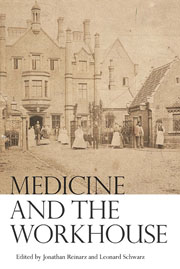Book contents
- Frontmatter
- Contents
- Preface
- Introduction
- Part One The Old Poor Law
- 1 Contagion, Exclusion, and the Unique Medical World of the Eighteenth-Century Workhouse: London Infirmaries in Their Widest Relief
- 2 The Elderly in the Eighteenth-Century Workhouse
- 3 “These ANTE-CHAMBERS OF THE GRAVE”? Mortality, Medicine, and the Workhouse in Georgian London, 1725–1824
- 4 Workhouse Medical Care from Working-Class Autobiographies, 1750–1834
- 5 “A Sad Spectacle of Hopeless Mental Degradation”: The Management of the Insane in West Midlands Workhouses, 1815–60
- Part Two The New Poor Law
- Selected Bibliography
- List of Contributors
- Index
5 - “A Sad Spectacle of Hopeless Mental Degradation”: The Management of the Insane in West Midlands Workhouses, 1815–60
from Part One - The Old Poor Law
Published online by Cambridge University Press: 05 December 2013
- Frontmatter
- Contents
- Preface
- Introduction
- Part One The Old Poor Law
- 1 Contagion, Exclusion, and the Unique Medical World of the Eighteenth-Century Workhouse: London Infirmaries in Their Widest Relief
- 2 The Elderly in the Eighteenth-Century Workhouse
- 3 “These ANTE-CHAMBERS OF THE GRAVE”? Mortality, Medicine, and the Workhouse in Georgian London, 1725–1824
- 4 Workhouse Medical Care from Working-Class Autobiographies, 1750–1834
- 5 “A Sad Spectacle of Hopeless Mental Degradation”: The Management of the Insane in West Midlands Workhouses, 1815–60
- Part Two The New Poor Law
- Selected Bibliography
- List of Contributors
- Index
Summary
The significance of the workhouse in the tapestry of care for mentally disordered people in England has tended to be underestimated by historians. The nineteenth century has been regarded principally as the era of the rise and triumph of the universal, monolithic public lunatic asylum system. County authorities were first empowered to establish a pauper lunatic asylum as early as 1808. Several had taken the opportunity before the key legislation of 1845 mandated counties and boroughs to provide an asylum. Within a decade almost every county had built an asylum, on its own or in conjunction with others, or was in the process of doing so. These great “museums of madness,” as Andrew Scull has evocatively styled them, laid the basis of institutional provision for generations to come. Between 1850 and 1900 the numbers and size of the county asylums continued to expand steadily, as did the numbers of people confined within them.
The purpose-designed county lunatic asylum was, however, never the sole institutional receptacle. During the eighteenth century and the first half of the nineteenth, there had been a considerable growth of provision in the private and voluntary sectors. Private madhouses had originally catered to the insane members of the wealthier classes, but some were increasingly providing for pauper lunatics funded by their parishes. Lunatic hospitals, financed by voluntary subscription, had been established in several major cities, and these also accepted some paupers among their clientele.
- Type
- Chapter
- Information
- Medicine and the Workhouse , pp. 103 - 120Publisher: Boydell & BrewerPrint publication year: 2013

